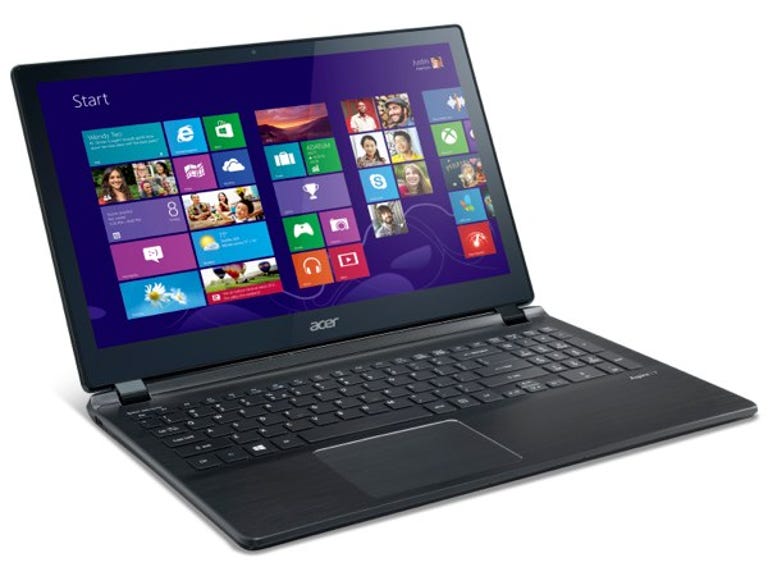 Why You Can Trust CNET
Why You Can Trust CNET Acer Aspire V7 review: Acer Aspire V7
Acer's Haswell workhorse might not pack any remarkable features, but this rather uninteresting product will get the job done with a minimum of fuss.
With so many laptops now focusing on highly specialised niches, it's refreshing to see something like the Aspire V7 arrive. Aimed squarely at the middle of the pack, the V7 is designed for the average, everyday user. This jack of all trades is intended to work well across a variety of scenarios, be it watching a movie, planning a PowerPoint presentation or checking in on Facebook. It doesn't have any flashy gimmicks, and won't transform like an Autobot when a secret button is clicked. Instead, Acer has aimed to deliver a solid, well-specced laptop at a competitive price. Has it achieved greatness by aiming for the average?
The Good
The Bad
The Bottom Line
Design and features
The heft of the V7 comes as something of a surprise, especially as it's proudly wearing an ultrabook label. Tipping the scales at 2.1kg, it's lightweight by 2010 standards, but in this day and age feels surprisingly bulky. The large 15-inch screen ensures a relatively roomy chassis and the 21mm height at its thickest point means the V7 only barely scrapes into official Intel ultrabook territory.
The dark finish of our sample made it hard to determine the material used in the exterior, but research revealed that it wasn't the plastic we'd originally guessed. Brushed aluminium is used on the exterior of the display and keyboard, while the rubber coating of the base makes it impossible to determine if plastic or metal has been used. Surprisingly, there are no access panels underneath for replacing the hard drive or upgrading the memory — which is worth noting if you like to tinker.
A standard island keyboard is included, along with a generously proportioned number pad, and the backlighting makes it easy to see when you're taking notes in the dark. The touch pad is as responsive as it is smooth, though the buttons felt a little too ambiguous for our liking. Not that you'll always be using the touch pad, as the 15.6-inch screen is touch enabled, a perfect match for the Windows 8 operating system.
While the touch controls are nice and accurate, it's obvious that they've been included at the cost of the display's resolution. Acer's claims of an HD screen are a bit dated, as the native resolution of 1366x768 isn't close to the 1920x1080 full HD standard found elsewhere. Pixel structure is very obvious at normal working ranges, giving the entire screen a grainy look. This low-fidelity screen is arguably the biggest weakness of the V7.
Connections, performance and battery
Skirting around the sides of the V7 reveals a healthy range of connections. The right side is home to the 3.5mm stereo mini-jack for audio output, alongside an SD Card slot and USB 2.0 port. The opposite side is devoid of any ports other than a single USB 2.0 port next to the power button. Finally, the rear houses the HDMI out, a single USB 3.0 port, an expanding Ethernet port and a Kensington lock slot.
Delving into the machine's innards reveals the new Haswell CPU powering the V7. Our review sample arrived with the 4th Generation Core i7-4500U, Intel's mid-range mobile CPU that ramps up to 3GHz under load. The same chip takes care of all graphics duties, courtesy of the mid-range Intel HD Graphics 4400 integrated GPU. 8GB of DDR3 memory is plenty, but its slow 1066MHz speed is well below that offered elsewhere. Finally, a 500GB mechanical hard drive is supplemented by a tiny 20GB SSD for caching duties.
These components combine to deliver — you guessed it — middle-of-the-road performance. In our overall productivity and application performance test, PCMark 8, the V7 arrived in the dead centre of our results. Ditto with our game tests, both of which suggest that this machine simply can't stomach the current generation of PC games. Our final benchmark, PowerMark, puts the PC under heavy load until the battery is just about dead. The V7's 3560mAh Lithium Polymer performed surprisingly well, lasting over three hours at 218 minutes, making it one of the longer-living machines in our round-up.
Choose a benchmark: PCMark 8 | Tomb Raider | Hitman Absolution
Conclusion
It might not be the smallest, fastest or sexiest Haswell-powered ultrabook on the market, but the V7 does what it sets out to achieve. Offering decent performance wrapped in respectable features at a reasonable price, it's the very definition of ordinary. If the screen was truly HD, we'd bump the score up significantly, but as it stands, this is a decent workhorse for those who just need an average laptop.


